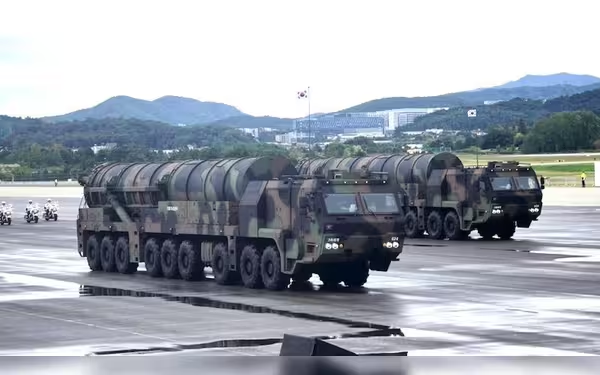Sunday, October 6, 2024 12:37 AM
North Korea's Missile Advancements Heighten Tensions with South Korea
- North Korea develops new road-mobile missile launcher.
- Hwasong-18 missile could reach continental United States.
- Escalating arms race threatens regional and global security.
 Image Credits: asiatimes
Image Credits: asiatimesNorth Korea's missile advancements escalate tensions with South Korea, raising concerns over regional and global security.
In recent months, tensions between North and South Korea have escalated, with both nations engaged in a fierce competition to develop larger and more advanced missile systems. This ongoing arms race is not just about military might; it reflects deeper geopolitical strategies and the desire for dominance in the region. South Korea has openly threatened to target the leadership of North Korea, while Pyongyang is focused on undermining the United States' extended deterrence guarantees for its southern neighbor.
Last month, a report from 38North revealed a striking image of North Korean Supreme Leader Kim Jong Un standing beside a new road-mobile missile launcher chassis. This new vehicle boasts at least 12 axles, indicating it is longer than the previous 11-axle Transporter-Erector Launcher (TEL) used for the Hwasong-17 intercontinental ballistic missile (ICBM). The development of this new chassis suggests that North Korea is committed to enhancing its road-mobile missile capabilities, which are crucial for strategic mobility and surprise attacks.
While the exact purpose of this new TEL remains uncertain, experts believe it could be linked to a longer-range ICBM or even a space-launch vehicle (SLV). The limited information available does not confirm its specific use, but the vehicle's design and military paint job imply it is intended for a new type of ballistic missile TEL. This advancement highlights North Korea's ability to produce its own TELs and its strategic focus on improving missile technology.
According to 38North, the new TEL may support a larger payload, multiple warheads, or decoys, which would significantly enhance the missile's range and effectiveness. It could potentially serve as a launcher for a follow-on design for North Korea's Hwasong-18 ICBM. The Hwasong-18, noted for its solid-propellant design, offers several advantages, including easier field operation, reduced support vehicle requirements, and improved concealment, making it a more reliable and survivable option for North Korea.
Furthermore, the Hwasong-18 is reported to have a potential range of up to 15,000 kilometers on a non-lofted trajectory, which means it could reach anywhere in the continental United States, depending on the weight of its payload. Although the exact number of Hwasong-18 missiles and their production rate remain unknown, it is anticipated that this missile will augment, rather than replace, North Korea's existing ICBM arsenal.
As the situation continues to evolve, it is essential for the international community to monitor these developments closely. The arms race between North and South Korea not only poses a threat to regional stability but also raises concerns about global security. Understanding the implications of these advancements in missile technology is crucial for policymakers and citizens alike, as they navigate the complexities of international relations in an increasingly volatile world.













